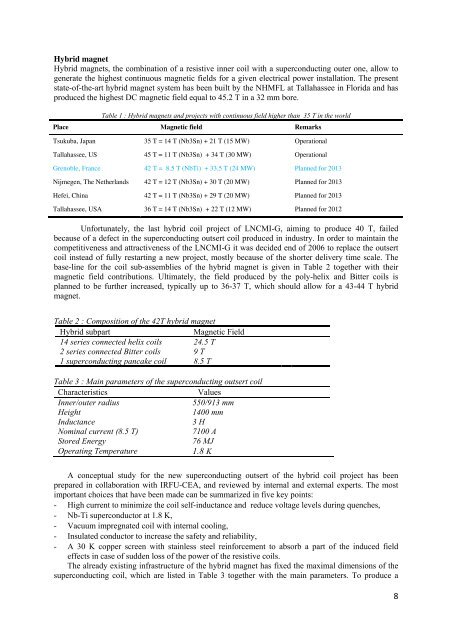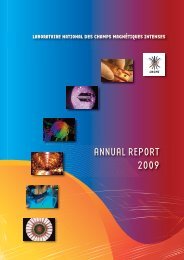Laboratoire National des Champs Magnétiques Pulsés CNRS – INSA
Laboratoire National des Champs Magnétiques Pulsés CNRS – INSA
Laboratoire National des Champs Magnétiques Pulsés CNRS – INSA
You also want an ePaper? Increase the reach of your titles
YUMPU automatically turns print PDFs into web optimized ePapers that Google loves.
Hybrid magnet<br />
Hybrid magnets, the combination of a resistive inner coil with a superconducting outer one, allow to<br />
generate the highest continuous magnetic fields for a given electrical power installation. The present<br />
state-of-the-art hybrid magnet system has been built by the NHMFL at Tallahassee in Florida and has<br />
produced the highest DC magnetic field equal to 45.2 T in a 32 mm bore.<br />
Table 1 : Hybrid magnets and projects with continuous field higher than 35 T in the world<br />
Place Magnetic field Remarks<br />
Tsukuba, Japan 35 T = 14 T (Nb3Sn) + 21 T (15 MW) Operational<br />
Tallahassee, US 45 T = 11 T (Nb3Sn) + 34 T (30 MW) Operational<br />
Grenoble, France 42 T = 8.5 T (NbTi) + 33.5 T (24 MW) Planned for 2013<br />
Nijmegen, The Netherlands 42 T = 12 T (Nb3Sn) + 30 T (20 MW) Planned for 2013<br />
Hefei, China 42 T = 11 T (Nb3Sn) + 29 T (20 MW) Planned for 2013<br />
Tallahassee, USA 36 T = 14 T (Nb3Sn) + 22 T (12 MW) Planned for 2012<br />
Unfortunately, the last hybrid coil project of LNCMI-G, aiming to produce 40 T, failed<br />
because of a defect in the superconducting outsert coil produced in industry. In order to maintain the<br />
competitiveness and attractiveness of the LNCMI-G it was decided end of 2006 to replace the outsert<br />
coil instead of fully restarting a new project, mostly because of the shorter delivery time scale. The<br />
base-line for the coil sub-assemblies of the hybrid magnet is given in Table 2 together with their<br />
magnetic field contributions. Ultimately, the field produced by the poly-helix and Bitter coils is<br />
planned to be further increased, typically up to 36-37 T, which should allow for a 43-44 T hybrid<br />
magnet.<br />
Table 2 : Composition of the 42T hybrid magnet<br />
Hybrid subpart Magnetic Field<br />
14 series connected helix coils 24.5 T<br />
2 series connected Bitter coils 9 T<br />
1 superconducting pancake coil 8.5 T<br />
Table 3 : Main parameters of the superconducting outsert coil<br />
Characteristics Values<br />
Inner/outer radius 550/913 mm<br />
Height 1400 mm<br />
Inductance 3 H<br />
Nominal current (8.5 T) 7100 A<br />
Stored Energy 76 MJ<br />
Operating Temperature 1.8 K<br />
A conceptual study for the new superconducting outsert of the hybrid coil project has been<br />
prepared in collaboration with IRFU-CEA, and reviewed by internal and external experts. The most<br />
important choices that have been made can be summarized in five key points:<br />
- High current to minimize the coil self-inductance and reduce voltage levels during quenches,<br />
- Nb-Ti superconductor at 1.8 K,<br />
- Vacuum impregnated coil with internal cooling,<br />
- Insulated conductor to increase the safety and reliability,<br />
- A 30 K copper screen with stainless steel reinforcement to absorb a part of the induced field<br />
effects in case of sudden loss of the power of the resistive coils.<br />
The already existing infrastructure of the hybrid magnet has fixed the maximal dimensions of the<br />
superconducting coil, which are listed in Table 3 together with the main parameters. To produce a<br />
8







